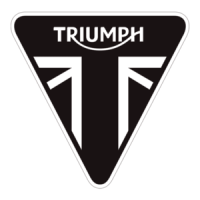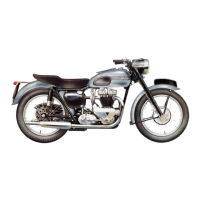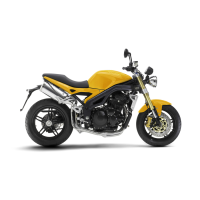1
GEARBOX
The gearbox employed has four speeds and is very robustly constructed.
It
will
require very little attention, and,
if
its oil change intervals are strictly adhered to
and the security of
its
clamping bola occasionally checked, the life of the gearbox
will be greatly prolonged.
For the rider who wishes to use his machine in one or more of the various com-
petitions or for road racing, a set of gears
can
be made available to suit the particular
conditions. To change from STANDARD to WIDE ratio, four gears are required,
namely-mainshaft high, mainshaft second, layshaft high and layshaft second. The
speedometer driven gears will also have to be ctianged to correct the speedom'eter
to gearbox ratio. To
fit
CLOSE ratio gears a complete set is required and
as
no
provision
is
made for the speedometer gears, a sealing plug
is
supplied.
A
tacho-
/
meter driven off the exhaust
am
gear is employed for the purpose of checking the
I
engine revolutions when close ratio gears are fitted.
On
page
207
an "Engine
Revolution" and "Gear Ratio" chart will
be
found which will assist the rider in
choosing a suitable combination of gears.
I
Briefly, the gearbox operates in the following manner:
Gear selections are made by depressing or raising the pedal. The pedal is attached
to the plunger quadrant which is spring loaded on either side of its axis. After the
pedal has been operated,
it
will automatimlly return to the central position for the
next selection. When the pedal
is
depresed the upper quadrant plunger moves
under the guide plate, whereas the lower one, being released, connects with the
gear operating quadrant which
is
geared to the camplate.
The camplate
is
rotated by the gear quadrant, the movement being arrested by a
spring loaded plunger which
is
sprung into a notch in the camplate periphery. As
the camplate rotates, the gear selector forks which are connected, move along their
spindle and in turn shift the gears. Fig.
24
shows clearly all the working parts and
before attempting to dismantle the gearbox, the illustration should be carefully
studied.
FAULTY GEAR SELECTION
A badly adjusted clutch
is
one of the chief causes of faulty gear selection.
Always
ensure that the clutch plates spin true and that the correct grade of oil
is
employed
(See page
200
for further information).
Gearchange pedal springs may
be
fatigued or broken, thus preventing the pedal from
centralizing itself. Remedy+hange both springs.
Quadrant Plunger Sticking. To remedy, remove the plunger and polish the
bearing surface with smooth emery until the plunger
will move freelj in
its
housing.
I
It
is
a good plan to renew the plunger springs if this fault occurs.
I
Camplate Plunger Sticking. To remedy, remove the domed nut from.the
bottom of the gearbox casing and apply the same remedy
as
@r Quadrant Plungers.
Slackness of the nuts securing the kickstarter assembly or clutch centre.
As both these parts are attached to the gearbox mainshaft, either becoming loose
would allow the mainshaft
to
hat and cause a faulty selection. Remedy--obvioirs.

